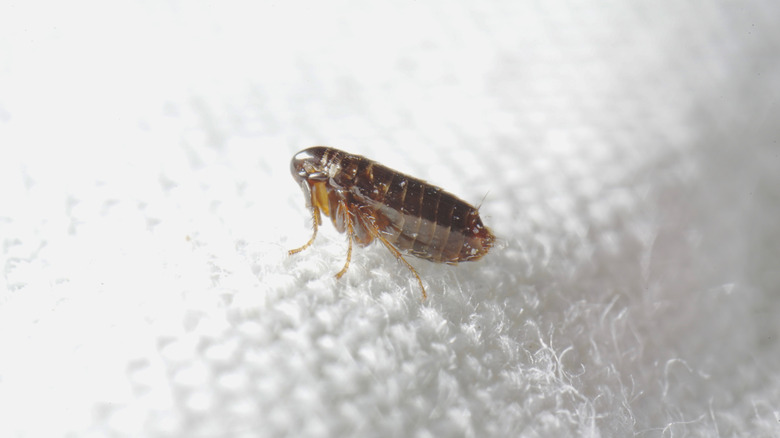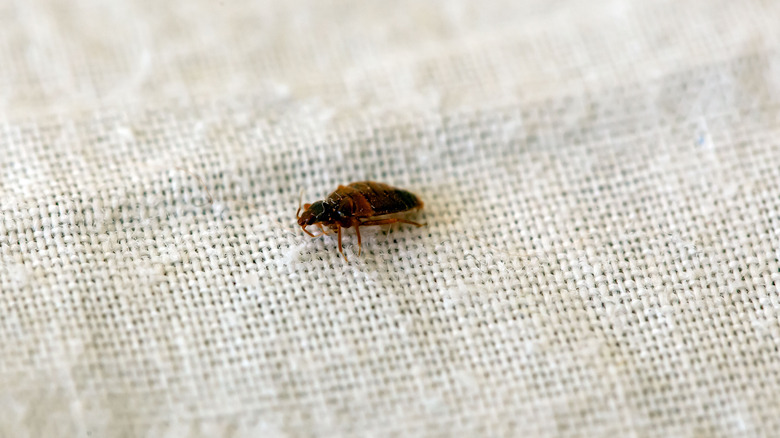Are Those Icky Bed Bugs Actually Fleas?
Yikes! You just spotted a questionable bug in your home. One minute, it looks like a bed bug. The next, it resembles a flea. Now you're not sure what it is anymore. Both pests are tiny, eat blood, cause itchy bumps, and multiply quickly. Plus, they're both a pain to deal with. To cut through the confusion, we tapped Dr. Jim Fredericks, board-certified entomologist and senior vice president of public affairs at the National Pest Management Association, for advice on distinguishing the two.
The first, most obvious clue is their modes of transportation. "Neither pest has wings to fly, but fleas can jump from host to host, while bed bugs only crawl," the expert exclusively explained to us. Then there's the difference in eating habits. "Fleas will remain on their host and stay hidden... while bed bugs will bite, feed for five to 10 minutes, and then recede back into a dark space, like your mattress seams, to digest the blood meal." In either scenario, Fredericks suggests calling an exterminator. Not only can a pest control professional properly identify the invader, they can also keep the infestation from spiraling out of control.
How to identify fleas
Although similar looking to bed bugs, fleas are shaped differently. "Fleas have a laterally compressed body when viewed from above, [with] six long legs that are well adapted for jumping," Dr. Jim Fredericks exclusively told House Digest. They're also "smaller than ⅛ of an inch." Color-wise, these little guys are more so dark brown, but redden after eating.
According to Dr. Fredericks, fleas prefer feasting on animals, hence why you mostly find them on cats, dogs, rabbits, and rats. That's not to say they don't nibble on human blood, though — they do if given the chance. "Beyond an itchy bite, fleas are vectors of the bubonic plague and the bacterial disease murine typhus," the pest expert warns. No one wants that, including your pet.
If the pests you're dealing with are really fleas, head straight to your veterinarian for flea medications if you have pets. Regularly vacuuming floors, washing bedding, and cleaning hiding spots (such as furniture upholstery) can also help get rid of fleas in your home. But there's more: "Since fleas can hitchhike on wildlife, it's important to keep vertebrate pests like rodents, raccoons, and opossums out of your house. [Seal] and [screen] attic and crawlspace openings and [eliminate] gaps or holes in a building where pests might enter," notes Dr. Fredericks.
How to identify bed bugs
Slightly bigger than fleas, bed bugs typically measure around 3/16 of an inch long. Dr. Jim Fredericks describes them as insects with "flat bodies before eating and broad, oval, swollen, elongated, reddish-brown bodies after feeding." Their meal of preference? Humans.
Of course, getting rid of bed bugs is a whole other story since they're notoriously known for being stubborn and resilient. "Bed bugs like to hide in dark cracks and crevices, so evidence of infestation is often found close to these areas," Dr. Fredericks exclusively pointed out to us. "Check linens, mattresses, and cushions for reddish-brown spots, molted exoskeletons, or bed bug eggs before unpacking." Yep, these problematic pests are passionate travelers, too. For that reason, you should always inspect your luggage, bags, and second-hand purchases thoroughly if they've just been from a foreign land. Dr. Fredericks also says to "wash all clothes — whether they've been worn or not — and dry them on a high-heat setting to kill any hitchhikers." While their bites are far from favorable, at least bed bugs don't spread diseases like fleas. That's a tiny plus.


